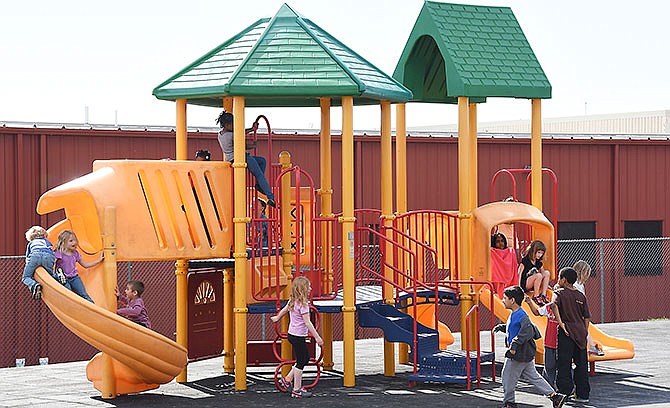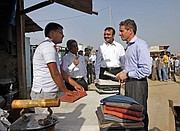Callaway Hills Elementary students packed their school gymnasium earlier this week, dancing to upbeat music during a Zumba class.
More than 80 students in the school's new Fit Club followed the lead of a YMCA Zumba instructor - intently watching and mirroring her movements. In the crowd was Maddie Kinneman, a third-grade student with an interest in physical fitness and health. When the school offered Fit Club after school, Kinneman joined to avoid being sedentary after school, watching TV while waiting for her mom to come home from work.
The Missouri Foundation for Health awarded Capital Region Medical Center its Healthy Schools, Healthy Communities (HSHC) grant, which is designed to fight the epidemic of childhood obesity in four Jefferson City School District elementary schools - Callaway Hills, East, South and Thorpe Gordon. Selected schools must have a free and reduced lunch rate of 60 percent or more to qualify for the grant.
Nicole Stacey, Capital Region wellness coordinator, is leading the charge and collaborating with administrators and teachers to kickstart programs within each school. She and school officials determined how to spend the $40,000 of grant funds available for 2016 in an action plan outlined earlier this year. The grant allocation is needs based, she said, and some schools will receive more grant funding than others.
The breakdown of grant allocation is: $9,490 for Thorpe Gordon, $7,790 for South, $6,990 for East and $6,368 for Callaway Hills. That leaves about $9,500 of the total funding left, which Stacey said will be used on additions to the action plans that will primarily focus on nutrition education.
Within the grant's five-year period, the mission is to decrease elementary students' body mass index by 5 percent.
Though early in the process, the initiative has already made an impact on Kinneman - as evident by a persuasive paper she recently wrote on the need for a Holts Summit YMCA. The 8-year-old girl envisions a place where people can play football and basketball, lift weights, burn calories using cardio equipment, run and walk on a track, and swim and dive in a pool.
"It could make us healthy and ready for school and ready to learn," she said in her paper. "It could make us motivated for school and to eat healthy. It could make Callaway Hills and our community happy."
Among the schools' action plans, initiatives and programs include:
• Spark Physical Education Curriculum and Nutrition Education Curriculum. The curriculum will be new for the schools and provides "innovative approaches to physical education and instruction, then to test in the "real world' settings," according to the action plans;
• Water bottle refilling stations. Children carrying water bottles will have the option to drink more water throughout the school day;
• Walking classrooms. Students listen to a lesson on a podcast while walking and then discuss it later in class;
• GoNoodle "brain breaks." Teachers will take short breaks with their students to get them moving using the free website gonoodle.com;
• Cooking classes, new basketball hoops at Callaway Hills Elementary and a traveling trophy to reward teachers and classrooms making healthy choices.
In the U.S., childhood obesity rates have more than doubled in the past 30 years, according to the Centers for Disease Control (CDC). A 2012 study revealed more than one-third of children and adolescents are overweight or obese. Research shows obese children are more likely to become obese adults, leading to health complications such as heart disease, high blood pressure and diabetes.
The CDC lists short-term health effects can include bone or joint problems, sleep apnea, and social and psychological problems, such as stigmatization and low self-esteem, while still in early stages of life.
In December, Stacey weighed and measured each student. She said she's observed students at varying levels of health, but it is never her position to judge the children - only show them ways to lead a healthy lifestyle.
"I think we have children who are very healthy; I think we have children who are malnourished; I think we have children who are obese and sediment, sitting around not getting out," Stacey said. "A lot of that has to do with society. Most parents have to work, so the safe place for children is inside versus back in the day when mom and dad would lock to door and say, "Stay outside. If you want to come in, you have to stay in.'"
That's why Fit Club is being offered after school, giving students a safe space to be active. Justin Reynolds, Callaway Hills physical education teacher, said he thought no more than 40 students would show up for the club, but now, the attendance numbers are pushing 90. It's evidence, he said, children need to move.
Give children options and opportunities for healthy living, Reynolds said, and they will respond.
"It showed me that kids are craving for something to do after school," he said.
Each Fit Club member was given an ingredients book and a journal to track their amount of exercise and healthy eating.
"We can see how unhealthy we were eating and how bad our bodies were functioning when we ate all the bad stuff like pizza," Kinneman said. "And then when we started the Fit Club, they wanted us to track and see how healthy we've gotten."
Some of the same children in Fit Club were getting their hands dirty at Callaway Hills' Garden Club on Thursday. For an hour following the end of the school day, more than 30 children potted green, leafy plants. They worked in two raised garden beds, full of a variety of vegetables - broccoli, cauliflower, spinach, lettuce, kale, cabbage, tomatoes, radishes and more. With grant funding, Callaway Hills will add four more raised garden beds. Thorpe Gordon Elementary will eventually establish its own six-bed school garden.
Julie Long, a gardener and volunteer, helped establish Garden Club years ago with Tina Wheeler, a former Callaway Hills teacher. Garden Club exposes children to certain vegetables for the first time, Long said. Many can be reluctant to taste test what they're growing, but she said she's seen even the most weary children snap off and eat broccoli from the garden.
Students went home with oregano, chives and a recipe this week. By bringing spices and vegetables to their families, Long said she hopes it sparks a conversation about healthy foods. She also wants children to be able to identify the good-for-you foods while shopping at the grocery store.
"If they can identify what's in a grocery store, maybe if they go with Mom and say, "We've tried that at school - it's good.' I'm hoping that they get enough basic education that they can promote that (to their parents), or at least talk to their siblings about (healthy foods)," she said.
Johnathan Isaac is a three-year Garden Club member, who said he "really likes broccoli now."
"I think (students) should get involved in the garden, and it's really fun," he said. "It's kind of like free food. All it really requires is a fragment of your time. I think if you have time, then start it because there's nothing better you can do."


